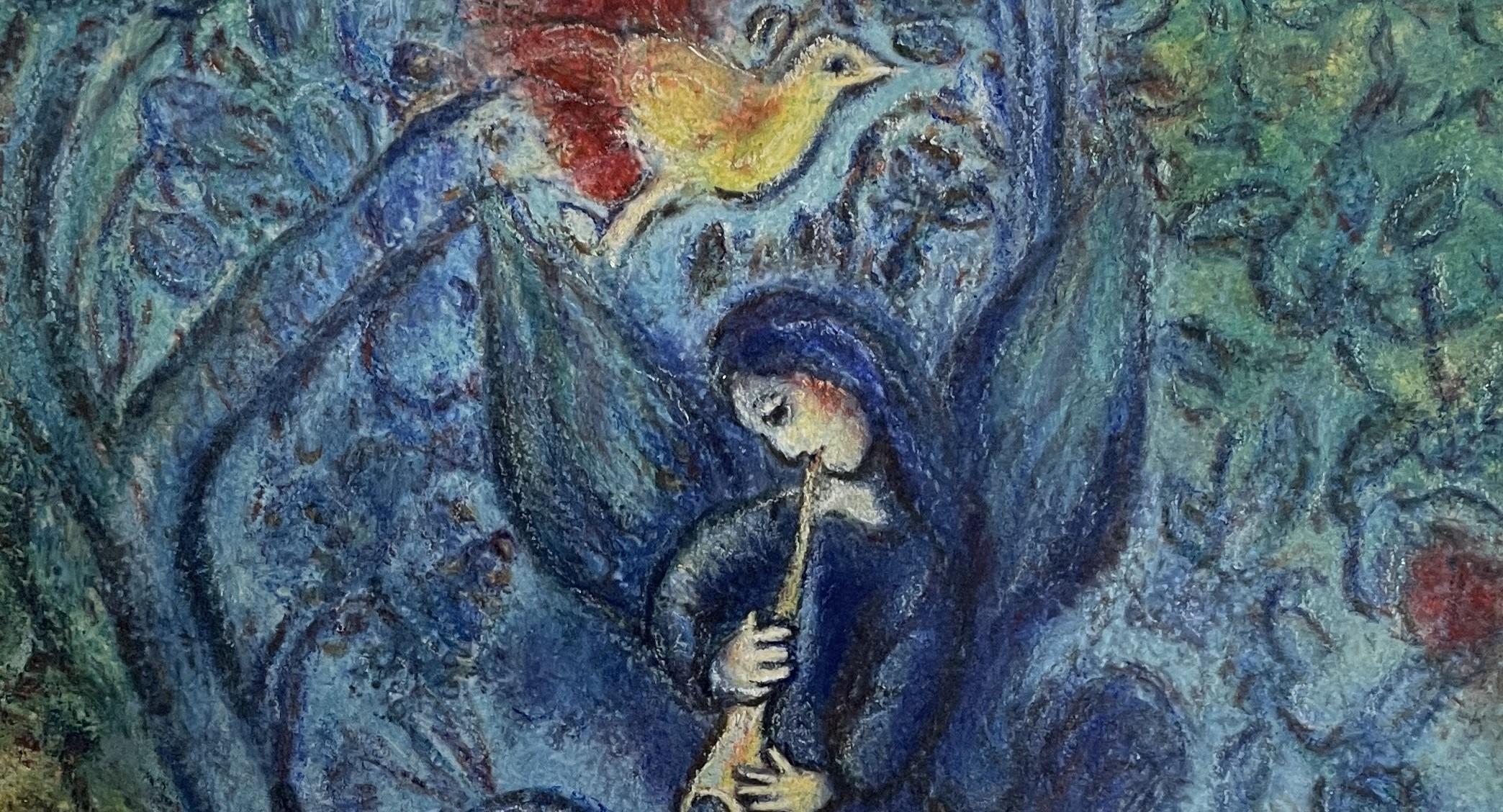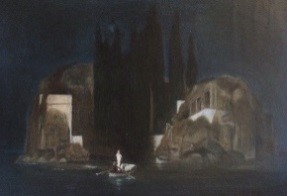日本語-Englishー台灣華語
アルノルド・ベックリン「死の島」
薄暗い闇の中、一艘の小舟が島に向かう。船頭に背を向けて白衣の人物が立っている。傍らには飾られた白い箱(棺桶)。小舟は白く輝く岸辺に近づいて行く。夜空にすっと伸びる糸杉は荒々しい岩肌で囲まれ、島には白い建物だけがそびえている。細波のかすかな気配が感じ取れるほど厳粛な静けさに包まれている。ベックリンは注文主に「この絵は暗い影の世界へ夢想して入り込むことを促す絵である」と述べている。
「死の島」は一度見たら二度と忘れることができない絵であるが、はじめて観るのに、どこかで知っているような不思議な印象を受ける。それはこの絵が、夢から発想を得た心の中にしまっておいた幻想を吐露した絵だからである。 死の島は、終焉とも新生ともとれる物語性の強い構図の絵である。それは死への鎮魂歌であると同時に、官能的な自然の生命を象徴している。
「死の島」を描いていると、それはまるで女性器に吸い寄せられるように選ばれた一つの精子が泳ぎ付くように、多くの犠牲を払いながら辿り着く生命の誕生を象徴しているようにも思えてくるのだった。ロシアの作曲家セルゲイ・ラフマニノフは死の島に霊感を得て、交響詩「死の島」を作曲している。その曲は、不気味な雰囲気に包まれる中、美しく透きとおる力強い旋律で死から始まる生を称えている。
「死の島」は五枚ある。それぞれの絵は同じタイトルでもかなり画面が異なっている。私は作者が最初に着手したバージョンを描くことにした。この絵は作者の出生地であるスイスのバーゼル美術館に所蔵されている。「死の島」の名前の由来となった有名な一枚が現在ベルリンの絵画館に所蔵されている。その絵は以前ヒトラーが保有し、総統執務室の壁にかけていたのは偶然ではないのかもしれない。「死の島」を見詰めていると、戦争の行き着く果てにたどる英雄の孤高の死を暗示しているように思えてくる。それは俗世間からの逃避と文明への悲観を表わしているのかもしれない。
ベックリンはヒトラーと同様風景画家として出発したが、象徴主義的幻想画家として有名になる。実生活でも夢を求め、画業のかたわら空を飛ぶ研究に没頭するが、その研究も大成することはなかった。スイスで生まれ、ドイツで活躍したベックリンは、生涯の殆どをイタリアで暮らした。「死の島」のモチーフとなったのはナポリのイスニア島であると言われているが、この絵には地中海の明るい光を感じることはできない。画家としても「死の島」を超える絵をついぞ描くことはなかった。ベックリンにとっては現実と幻想の区別はなく、「夢」が現実を生きる糧だったのかもしれない。
The Isle of the Dead
In the dim darkness, a small boat heads towards an island. A figure in white stands with their back to the boatman, beside them, a decorated white box (coffin). The boat approaches a shore that shines brightly. The night sky stretches with thread-like pines surrounded by rugged rock faces, and only white buildings tower on the island. It is enveloped in a solemn silence so profound that the faint presence of ripples can be sensed. Böcklin has stated to the patron, “This painting encourages one to dream and enter into the world of dark shadows.” “The Isle of the Dead” is a painting that once seen, can never be forgotten, yet upon first viewing, it imparts a mysterious impression as if it’s somehow familiar. This is because the painting expresses fantasies stored in the heart, inspired by dreams.
“The Isle of the Dead” is a painting with a strong narrative composition that can be interpreted as both an end and a rebirth. It is a requiem for death, yet simultaneously symbolizes the sensual life of nature. Drawing “The Isle of the Dead” feels like being drawn to a female genitalia, where a chosen sperm swims towards it, symbolizing the birth of life after many sacrifices. The Russian composer Sergei Rachmaninoff was inspired by “The Isle of the Dead” to compose a symphonic poem of the same name. His piece celebrates life that begins from death with a beautiful, powerful melody that resonates amidst an eerie atmosphere.
There are five versions of “The Isle of the Dead,” each differing significantly even though they share the same title. I decided to paint the version that the artist first began with. This painting is housed in the Basel Art Museum in Switzerland, the artist’s birthplace. The famous version that gave “The Isle of the Dead” its name is currently in the Berlin Picture Gallery. It was once owned by Hitler and hung on the wall of the Führer’s office, which may not be a coincidence. Staring at “The Isle of the Dead,” one might sense it hints at the solitary death of a hero at the end of war, possibly expressing an escape from the mundane world and a pessimism towards civilization.
Böcklin, like Hitler, started as a landscape painter but became famous as a symbolist fantasy painter. In real life, he sought dreams, dedicating himself to the study of flight alongside his painting, though this research never came to fruition. Born in Switzerland and active in Germany, Böcklin spent most of his life in Italy. It is said that the motif for “The Isle of the Dead” was the island of Ischia near Naples, but one cannot feel the bright light of the Mediterranean in this painting. As a painter, Böcklin never managed to surpass “The Isle of the Dead.” For him, the distinction between reality and fantasy may have been blurred, with “dreams” possibly being the sustenance for living reality.
阿諾爾德·貝克林《死亡島》
在昏暗的黑暗中,一艘小船正向著島嶼進發。船頭背對著站立著的是一位身穿白衣的人物。旁邊放著一個裝飾著的白色箱子(棺材)。小船正接近閃耀著白光的岸邊。夜空中的羅漢松直直伸展,被粗獷的岩石圍繞,島上只有白色建築聳立。周圍被一種可以感覺到細浪微動的莊嚴寂靜所包圍。貝克林對委託人說過:“這幅畫是鼓勵進入陰暗影子世界的夢想的畫。”《死亡島》是一幅一旦看過就再也忘不了的畫,但第一次看時,會有一種似曾相識的奇妙感覺。這是因為這幅畫是從夢中得到靈感,吐露了心中一直藏著的幻想。
《死亡島》是一幅具有強烈敘事性的構圖,既可以解讀為終結也可以是新生。它既是對死亡的安魂曲,同時也象徵著官能的自然生命。畫《死亡島》時,仿佛是一顆精子被吸引進入女性器官,經過許多犧牲最終達到生命誕生的象徵。俄羅斯作曲家謝爾蓋·拉赫曼尼諾夫受到《死亡島》的啟發,作曲了交響詩《死亡島》。這首樂曲在不祥的氛圍中,以美麗而清透的強大旋律讚美了從死亡開始的生命。
《死亡島》共有五幅,每幅畫即使標題相同,畫面也大不相同。我決定畫作者最初著手的版本。這幅畫現存於作者的出生地瑞士巴塞爾美術館。名為《死亡島》的著名畫作現在被收藏在柏林的畫廊中,這幅畫曾經是希特勒的所有,並掛在元首辦公室的牆上,這可能不是偶然的。凝視《死亡島》時,似乎暗示著戰爭終結時英雄孤獨的死亡。這或許表示了對俗世的逃避和對文明的悲觀。
貝克林雖然和希特勒一樣以風景畫家出道,但他以象徵主義的幻想畫家而聞名。他在現實生活中追求夢想,並在畫畫之餘熱衷於飛行研究,但這項研究未能取得重大成就。貝克林出生於瑞士,在德國活躍,終其一生大部分時間居住在意大利。《死亡島》的靈感來自於被認為是拿波里的伊斯基亞島,但這幅畫中感受不到地中海的明亮光芒。作為一名畫家,貝克林從未畫出超越《死亡島》的作品。對貝克林來說,現實和幻想之間沒有區別,“夢”可能是他生活的糧食。


